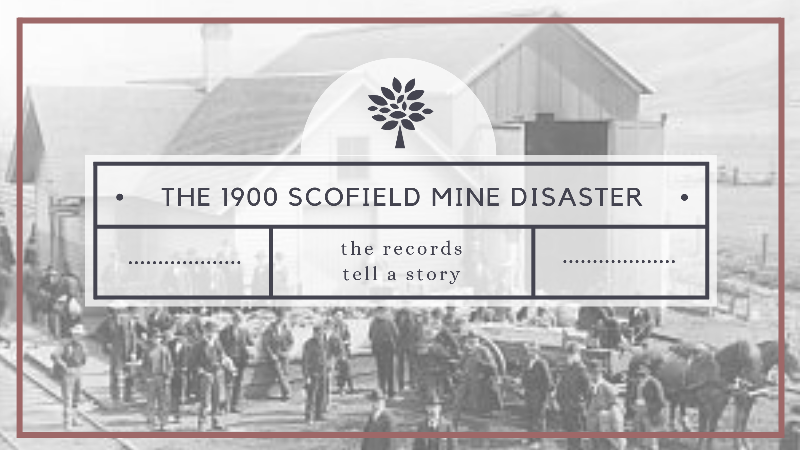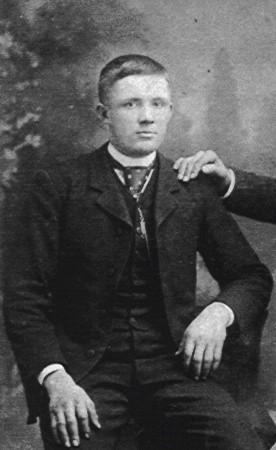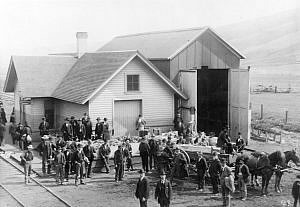
I have officially begun working on the accreditation process! My goal is to become accredited in the Mid-Atlantic Region of the United States by the end of 2020. If you are unfamiliar with this process, one of the requirements of Level 1 is to submit a four-generation project. The research project requires
I’m really excited for this project! My beginning ancestor will be Alfred Wakefield Beck, who was born and raised in Westmoreland County, Pennsylvania.

Alfred is the father of my husband’s Grandma Lois, and I although I am related to Alfred only through marriage, I have an additional connection with him: he is part of my own grandparents’ FAN club. My grandparents purchased a small country store from Alfred (or Old-Man Beck, as he was known by townsfolk) in Otto, Wyoming in 1941. I spent many happy hours in the store as a child, and when I found out that Grandma Lois had essentially grown up in the same store, I felt an immediate connection with her and the Beck family. At her request, my husband and I have been trying to extend her Beck line, specifically the line of Hannah Fisher, Alfred’s paternal grandmother. I am excited that this family will be the focus of my four-generation project.
I am currently in the process of gathering together source documents that have already been found for Alfred’s family. Family lore states that Alfred was a railroad engineer during his early adulthood, and that is all I have ever really heard about that period of his life. In my gathering process, I looked at the 1900 census record that was attached to Alfred on FamilySearch. The census shows that he was living in a boardinghouse in Scofield, Utah, and his occupation was Coal Miner.[2]

When I saw the information on the census record, I immediately clued in on something about Alfred’s life that I didn’t know before. He had most likely experienced and lived through one of the major mining disasters in history.
The reason the Scofield Coal Mine Disaster story was so recognizable to me is that a few years ago, I was a leader at our congregation’s annual Girls’ Camp, a week-long summer event for young women ages 12-18 in our area. The camp was held at Camp Helaman Hollow, a beautiful setting near Scofield Lake in central Utah. One of the activities at the camp was a visit to Scofield Cemetery, where we learned about the Scofield Mine Disaster of 1900.

Coal was discovered in Scofield in 1875, and the seemingly inexhaustible supply in this area led to Scofield becoming the most populous settlement in Carbon County during that time period. On May 1, 1900, an errant spark touched off an explosion in the Winter Quarters Mine #4. 100 miners were killed instantly, with 99 more
In spite of the disaster, the mine re-opened on May 28. Many of the miners who survived returned to the mines. Among those working there when the census was taken four days later on June 1,
From the Wikipedia article “Scofield Mine Disaster” I read the following:
Over the next two days {after the explosion} many people from the towns of Clear Creek and Scofield worked to remove the bodies and care for the dead and wounded. Most of the bodies from Number 4 were burned and mutilated and had to be placed in sacks whereas those killed by gas were loaded into coal carts by the dozen to be hauled out of the mine. The bodies were taken to the company boarding house to be cleaned up and dressed. They were then taken to the school house, where families anxiously waited to claim their husbands and sons. Many of the dead were laid to rest on May 5, 1900, during two large funerals. Every family in the town of Scofield was affected. The disaster left 107 widows and 268 fatherless children. In order to bury all of the dead, 75 caskets had to be imported from Denver, Colorado, because only 125 caskets could be brought in from Salt Lake City. 135 graves were dug at the Scofield cemetery, some of which were widened to hold fathers and sons. Funeral trains with more than 51 coffins carried the remaining miners home.[3]
Was the boarding house where the bodies were taken to be cleaned and dressed the one where Alfred lived? Was he one of the men who helped in the aftermath of this disaster? What were his feelings at this time? Even if he wasn’t actually there when the disaster occurred, he most certainly was involved with the people who were, and what I have read and learned about the disaster and its impact on the
My discovery of Alfred’s residence and occupation in 1900, along with my knowledge of historical events in the area, have provided the context for a snapshot of a period of his life that I had previously never seen. This is a great example of something I learned early on in my genealogical research: even when we don’t have diaries or personal histories about an ancestor, the records tell a story!
What stories have you learned from looking
at records of your ancestors’ lives?
[1] “Four Generation Project Guidelines”, ICAPGen, Guide to Applying for an Accredited Genealogist Credential, (icapgen.org : accessed 04/02/2019).
[2] 1900 United States Census, Carbon County, Utah, population schedule, Scofield Precinct, enumeration district (ED) 273, sheet 9A (penned), family 149, Alfred W. Beck in the household of Chas Hughes; digital image, FamilySearch, (http://www.familysearch.com : accessed 2 April 2019); citing NARA microfilm publication T623, FHL microfilm 1,241,682.
[3] “Scofield Mine Disaster,” Wikipedia (https://en.wikipedia.org/wiki/Scofield_Mine_disaster : accessed 4 April 2019)

Wow! That is fascinating. I learned through records that my 3rd great grandmother was a pauper inmate at the Boston, Lincolnshire Workhouse with her single mother in England before joining the church at age 14 and becoming a handcart pioneer. I’ve been studying about the poor law and poverty in England in Victorian times and it sounds awful. Walking across the plains sounds much better by contrast! She was with the first handcart company who successfully crossed during the summer months.
What a life! It is fascinating to learn details about ancestors’ lives in the records.